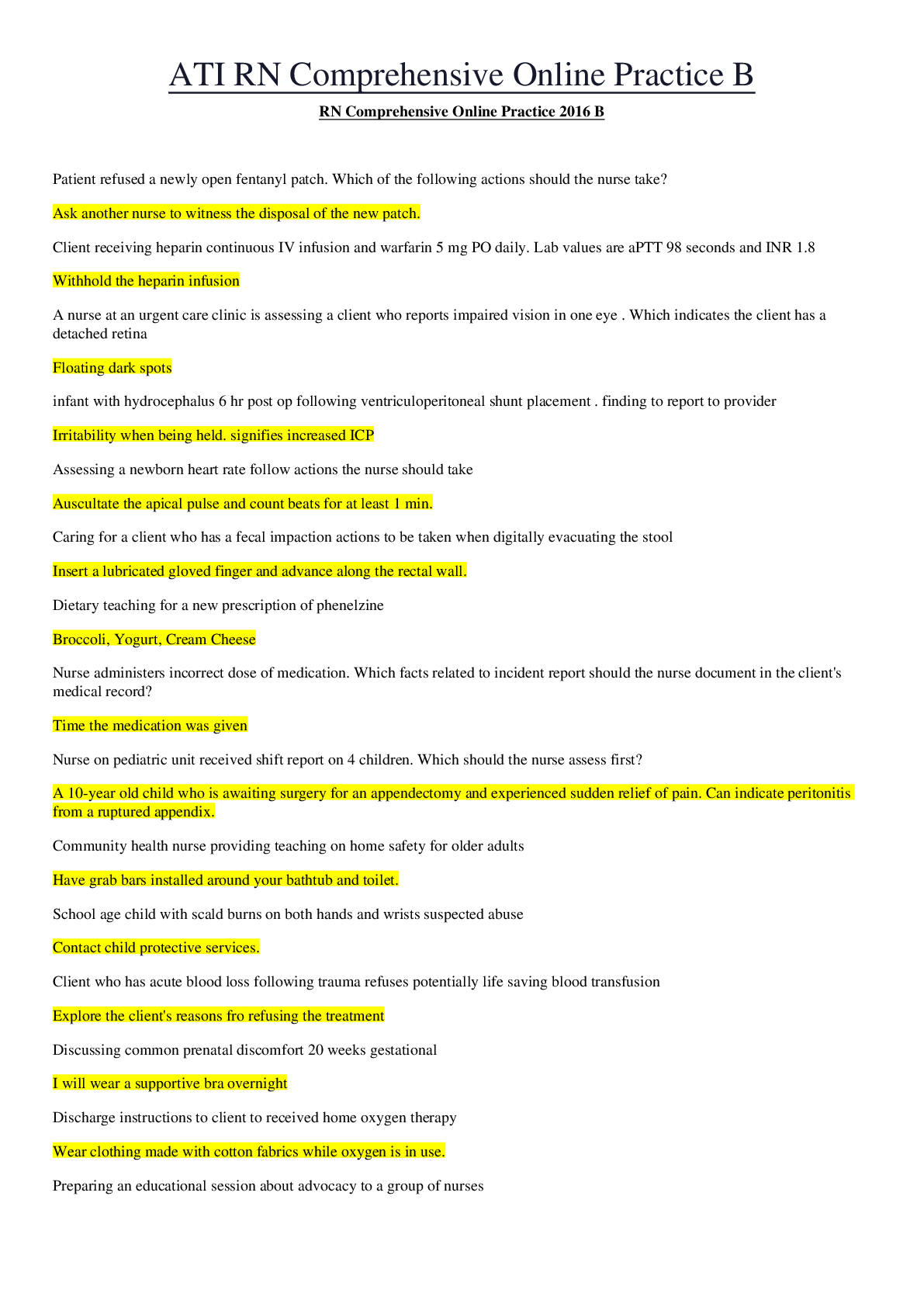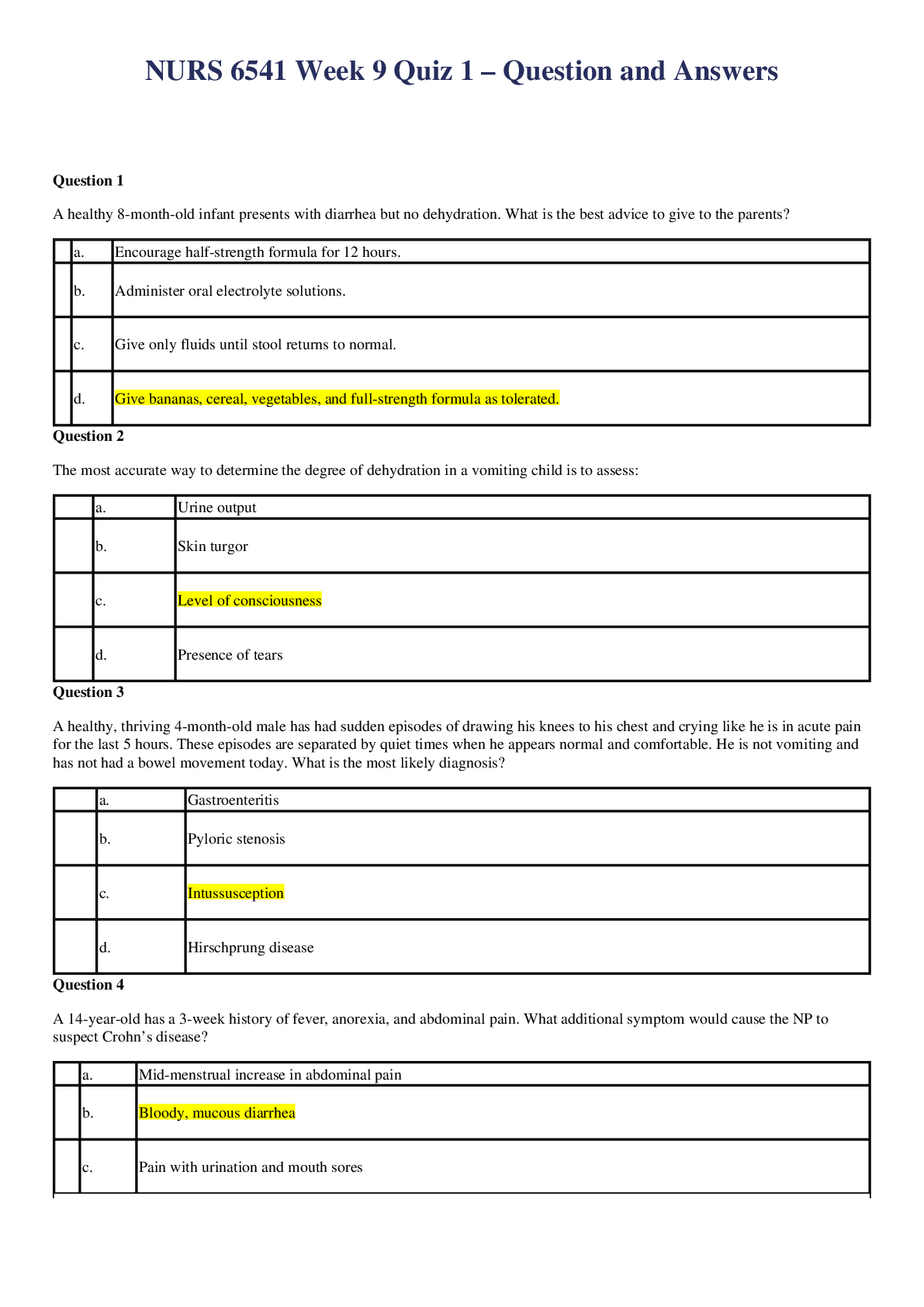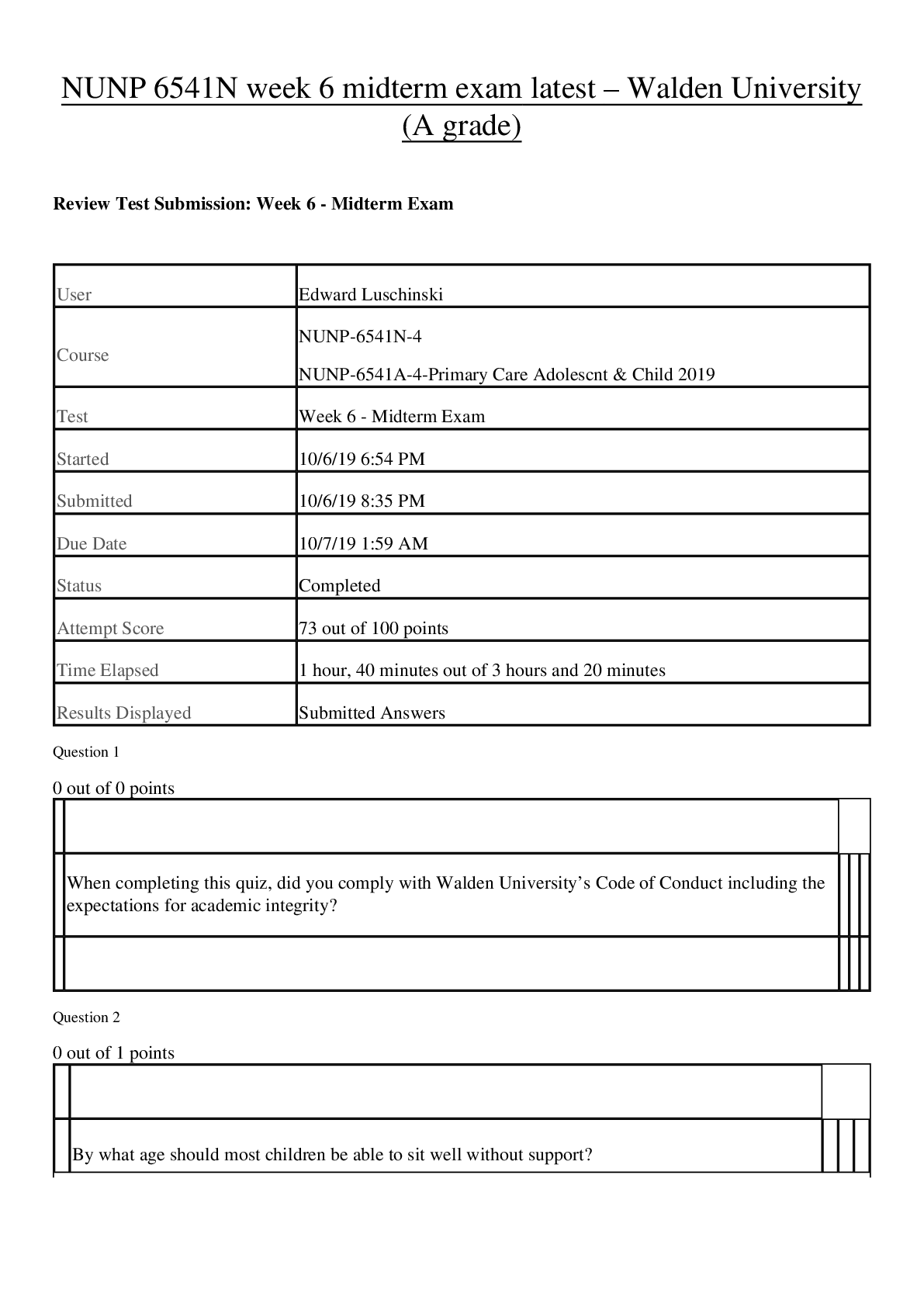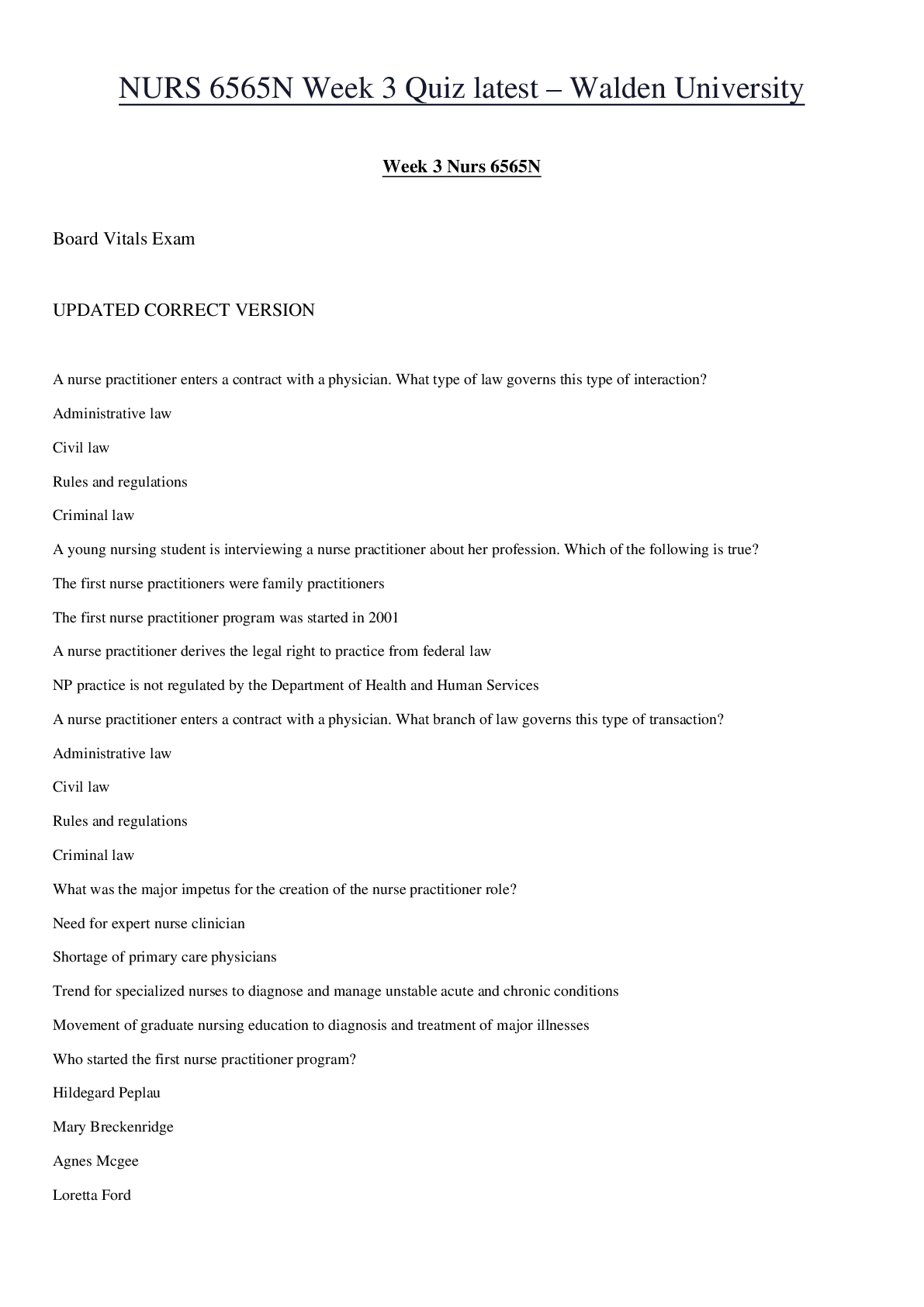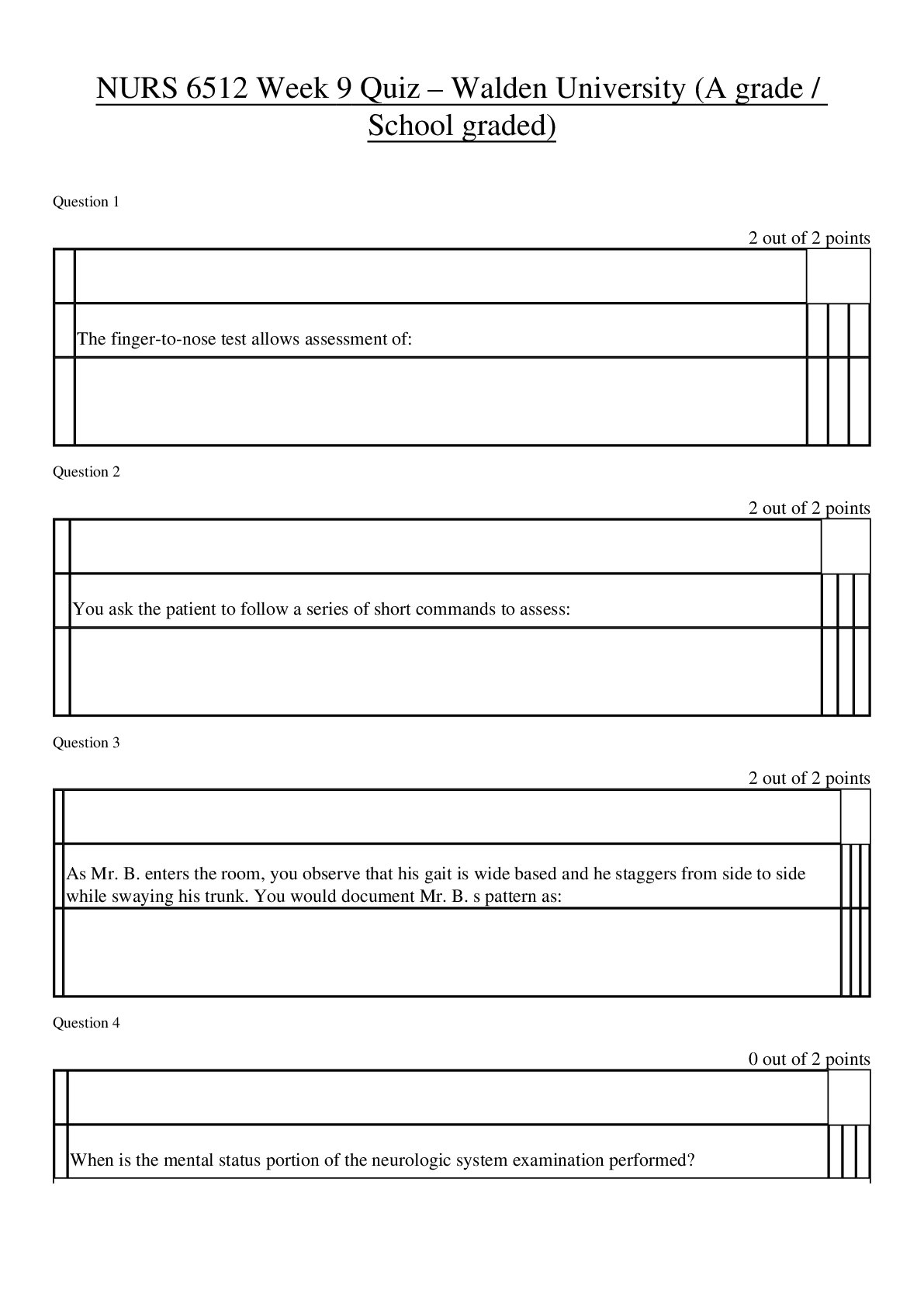*NURSING > EXAM > NURS 6512 Week 9 Quiz latest – Walden University | NURS6512 Week 9 Quiz latest (All)
NURS 6512 Week 9 Quiz latest – Walden University | NURS6512 Week 9 Quiz latest
Document Content and Description Below
NURS 6512 Week 9 Quiz latest – Walden University • Question 1 2 out of 2 points The finger-to-nose test allows assessment of: : coordination and fine motor function. ... : coordination and fine motor function. Response Feedback: To perform the finger-to-nose test, the patient closes both eyes, touches his or her nose with the index finger, alternating hands while gradually increasing the speed. This tests coordination and fine motor skills. All of the other choices test sensory function without motor function. • Question 2 2 out of 2 points You ask the patient to follow a series of short commands to assess: : attention span. : attention span. Response Feedback: A series of short commands for the patient to follow will test attention span rather than judgment, arithmetic calculations, abstract reasoning, or emotional stability. • Question 3 2 out of 2 points As Mr. B. enters the room, you observe that his gait is wide based and he staggers from side to side while swaying his trunk. You would document Mr. B. s pattern as: : cerebellar ataxia. : cerebellar ataxia. Response Feedback: Cerebellar gait (cerebellar ataxia) occurs when the patient s feet are wide based with a staggering gait, lurching from side to side, often accompanied by swaying of the trunk. Dystonic ataxia is jerky dancing movements that appear nondirectional. Steppage gait is noted when the hip and knee are elevated excessively high to lift the plantar flexed foot off the ground. The foot is brought down with a slap and the patient is unable to walk on the heels. Tabetic stamping occurs when the legs are positioned far apart, lifted high and forcibly brought down with each step; in this case the heel stamps on the ground. In Parkinsonian gait, the patient s posture is stooped and the body is held rigid; steps are short and shuffling, with hesitation on starting and difficulty stopping. • Question 4 0 out of 2 points When is the mental status portion of the neurologic system examination performed? : During the history-taking process : Constantly, throughout the entire interaction with a patient • Question 5 2 out of 2 points An aversion to touch or being held, along with delayed or absent language development, is characteristic of: : autism. : autism. Response Feedback: Autistic disorder involves a combination of behavioral traits (lack of awareness of others, aversion to touch or being held, odd or repetitive behaviors, or preoccupation with parts of objects) and communication deficits (usually echolalia [parrot speech]). • Question 6 2 out of 2 points Assessing orientation to person, place, and time helps determine: : state of consciousness. : state of consciousness. Response Feedback: Orientation to person, place, and time are measures of states of consciousness and awareness, not degrees of attention span. Analogies and abstract reasoning are higher functions than orientation. Emotional status can be better evaluated by observing behaviors. • Question 7 2 out of 2 points If a patient cannot shrug the shoulders against resistance, which cranial nerve (CN) requires further evaluation? : CN XI, spinal accessory : CN XI, spinal accessory Response Feedback: CN XI is responsible for the motor ability to shrug the shoulders. CN I is associated with smell reception and interpretation. CN V is associated with opening of the jaw, chewing, sensation of the cornea, iris, conjunctiva, eyelids, forehead, nose, teeth, tongue, ear, and facial skin. CN IX is associated with swallowing function, sensation of nasopharynx, gag reflex, taste, secretion of salivary glands, carotid reflex, and swallowing. CN XII is associated with movement of the tongue. • Question 8 2 out of 2 points To assess spinal levels L2, L3, and L4, which deep tendon reflex should be tested? : Patellar : Patellar Response Feedback: To assess spinal levels L2-L4, the patellar reflex should be tested. The patellar tendon is the only deep tendon that assesses the lumbar spinal level. The triceps, biceps, and brachioradial deep tendon reflexes are tested to assess the cervical spine, while the Achilles tendon is tested to assess the sacral spine. • Question 9 2 out of 2 points An acute polyneuropathy that commonly follows a nonspecific infection occurring 10 to 14 days earlier and that primarily affects the motor and autonomic peripheral nerves in an ascending pattern is: : Guillain-Barré syndrome. : Guillain-Barré syndrome. Response Feedback: Guillain-Barré syndrome (acute idiopathic polyneuritis) is an acute polyradiculoneuropathy that commonly follows a nonspecific infection that occurred 10 to 14 days earlier. It is characterized by ascending symmetrical weakness with sensation preserved. An increase in the severity occurs over days or weeks. A decrease or absent strength and sensory loss may result along with motor paralysis and respiratory muscle failure. • Question 10 2 out of 2 points The Denver II is a tool used to determine: : whether a child is developing as expected. : whether a child is developing as expected. Response Feedback: Denver II is a tool to determine whether the child is developing fine and gross motor skills, language, and personal social skills as expected according to the child s age. • Question 11 0 out of 2 points Which statement is true in regard to attention-deficit/hyperactivity disorder (ADHD)? : It is usually related to mental retardation. : It occurs before 7 years of age. • Question 12 2 out of 2 points Loss of immediate and recent memory with retention of remote memory suggests: : dementia. : dementia. Response Feedback: Dementia is the loss of both immediate and recent memory while retaining remote memories. ADHD is associated with recent and remote memory impairment; impaired judgments are thought process dysfunctions; and stupor is impaired consciousness. Delirium manifests with confusion with disordered perceptions as well as motor and sensory excitement with inappropriate reactions to stimuli. • Question 13 2 out of 2 points Environmental hazards and cognitive function are data needed for the personal and social history section of a neurologic assessment for: : every patient. : every patient. Response Feedback: Exposure to lead, arsenic, insecticides, organic solvents, dangerous equipment, and work at heights or in water are important factors to consider in the personal and social history of all patients. • Question 14 0 out of 2 points Diabetic peripheral neuropathy will likely produce: : exaggerated sharp touch sensation. : diminished pain sensation. • Question 15 2 out of 2 points Nerves that arise from the brain rather than the spinal cord are called: : cranial. : cranial. Response Feedback: Cranial nerves are peripheral nerves that arise from the brain rather than the spinal cord. Sympathetic, parasympathetic, and autonomic refer to the autonomic nervous system. Lower motor neurons arise in the spinal cord. • Question 16 2 out of 2 points The patient who is delirious usually: : maintains orientation to person. : maintains orientation to person. Response Feedback: The patient with delirium can have acute alterations in mental status, attention span, sleep patterns, and affect. The patient is unable to orient to time, place, or circumstance but remains oriented to person. • Question 17 2 out of 2 points Under most conditions, adult patients should be able to repeat a series of _____ numbers. : 5 to 8 : 5 to 8 Response Feedback: Most adults should be able to immediately recall a series of five to eight numbers forward and four to six numbers backward. • Question 18 2 out of 2 points Which condition is considered progressive rather than reversible? : Dementia : Dementia Response Feedback: Dementia is considered progressive and irreversible; delirium and coma have the potential for reversal; and depression and anxiety are reversible. • Question 19 2 out of 2 points Which area of the brain is responsible for perceiving sounds and for determining their source? : Temporal lobe : Temporal lobe Response Feedback: The temporal lobe is responsible for the perception and interpretation of sounds and determination of their source. The frontal lobe contains the motor cortex associated with voluntary skeletal movement. The occipital lobe contains the primary vision center. The parietal lobe is primarily responsible for processing received sensory data. The brainstem is the pathway between the cerebral cortex and the spinal cord, and it controls many involuntary functions. • Question 20 2 out of 2 points A woman brings her husband to the emergency department and states that he is having a stroke. You are the student NP on the hospitalist service and are sent down first to obtain the history and physical. You develop a differential diagnosis and know that the initial gold standard radiology test to further evaluate is: : CT of the brain without contrast : CT of the brain without contrast [Show More]
Last updated: 2 years ago
Preview 1 out of 11 pages

Buy this document to get the full access instantly
Instant Download Access after purchase
Buy NowInstant download
We Accept:

Reviews( 0 )
$12.00
Can't find what you want? Try our AI powered Search
Document information
Connected school, study & course
About the document
Uploaded On
Nov 14, 2020
Number of pages
11
Written in
Additional information
This document has been written for:
Uploaded
Nov 14, 2020
Downloads
0
Views
57








 – University of the People.png)
